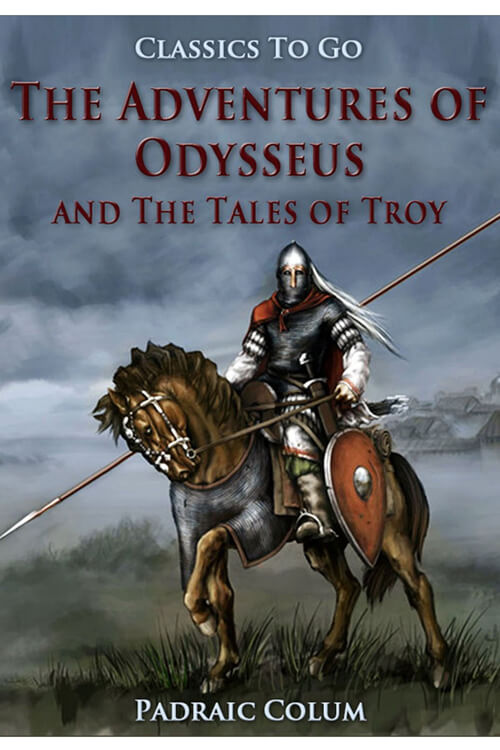
The Adventures of Odysseus and The Tales of Troy
It was when Telemachus was a child of a month old that a messenger came from Agamemnon, the Great King, bidding Odysseus betake himself to the war against Troy that the Kings and Princes of Greece were about to wage. The wise Odysseus, foreseeing the disasters that would befall all that entered that war, was loth to go. And so when Agamemnon’s messenger came to the island of Ithaka where he was King, Odysseus pretended to be mad. And that the messenger, Palamedes, might believe he was mad indeed, he did a thing that no man ever saw being done before—he took an ass and an ox and yoked them together to the same plow and began to plow a field. And when he had ploughed a furrow he sowed it, not with seeds that would grow, but with salt. When Palamedes saw him doing this he was nearly persuaded that Odysseus was mad. But to test him he took the child Telemachus and laid him down in the field in the way of the plough. Odysseus, when he came near to where the child lay, turned the plow aside and thereby showed that he was not a madman. Then had he to take King Agamemnon’s summons. And Agamemnon’s word was that Odysseus should go to Aulis where the ships of the Kings and Princes of Greece were being gathered. But first, he was to go into another country to seek the hero Achilles and persuade him also to enter the war against Troy.
And so Odysseus bade goodbye to his infant son, Telemachus, and his young wife Penelope, and his father, old Laertes. And he bade goodbye to his house and his lands and to the island of Ithaka where he was King. He summoned a council of the chief men of Ithaka and commended to their care his wife and his child and all his household, and thereafter he took his sailors and his fighting men with him and he sailed away. The years went by and Odysseus did not return. After ten years the City was taken by the Kings and Princes of Greece and the thread of war was wound up. But still, Odysseus did not return. And now minstrels came to Ithaka with word of the deaths or the homecomings of the heroes who had fought in the war against Troy. But no minstrel brought any word of Odysseus, of his death, or his appearance in any land known to men. Ten years more went by. And now that infant son whom he had left behind, Telemachus, had grown up and was a young man of strength and purpose.
Read or download Book
Padraic Colum
Padraic Colum (8 December 1881 – 11 January 1972) was an Irish poet, novelist, dramatist, biographer, playwright, children’s author and collector of folklore. He was one of the leading figures of the Irish Literary Revival.
Later life and work
In America, Colum took up children’s writing and published several collections of stories for children, beginning with The King of Ireland’s Son (1916). This book came about when Colum started translating an Irish folk tale from Gaelic because he did not want to forget the language. After it was published in the New York Tribune, Hungarian Illustrator Willy Pogany suggested the possibility of a book collaboration, so Colum wove the folktale into a long, epic story. Three of his books for children were awarded retrospective citations for the Newbery Honor. A contract for children’s literature with Macmillan Publishers made him financially secure for the rest of his life. Some other books he wrote are The Adventure of Odysseus (1918) and The Children of Odin (1920). These works are important for bringing classical literature to children.
He contributed to Emma Goldman’s Mother Earth.
In 1922 he was commissioned to write versions of Hawaiian folklore for young people. This resulted in the publication of three volumes of his versions of tales from the islands. At the suggestion of Dr Pádraic Whyte (School of English, Trinity College Dublin) a first edition of the first volume (At the Gateways of the Day) was presented to US President Barack Obama by Taoiseach Enda Kenny on the occasion of his visit to Dublin, Ireland on 23 May 2011. Colum also started writing novels. These include Castle Conquer (1923) and The Flying Swans (1937). The Columns spent the years from 1930 to 1933 living in Paris and Nice, where Padraic renewed his friendship with James Joyce and became involved in the transcription of Finnegans Wake.
After their time in France, the couple moved to New York City, where they did some teaching at Columbia University and CCNY. Colum was a prolific author and published a total of 61 books, not counting his plays. He adopted the form of Noh drama in his later plays.
While in New York, he wrote the screenplay for the 1954 stop-motion animated film Hansel and Gretel. It was his only screenplay.
Mary died in 1957 and Padraic finished Our Friend James Joyce, which they had worked on together. It was published in 1958. Colum divided his later years between the United States and Ireland. In 1961 the Catholic Library Association awarded him the Regina Medal. He died in Enfield, Connecticut, at age 90, and was buried in St. Fintan’s Cemetery, Sutton.
In 1965, Colum sold the notebooks, manuscripts, galley proofs, and letters that were in his apartments in New York and Dublin to the Binghamton University Libraries. He wished to make whatever resources he could available to scholars of Irish literature and history.
Asked how to say his name, he told The Literary Digest the last name was the same as the word column. “In my first name, the first a has the sound of au. The ordinary pronunciation in Irish is pau’drig.”






